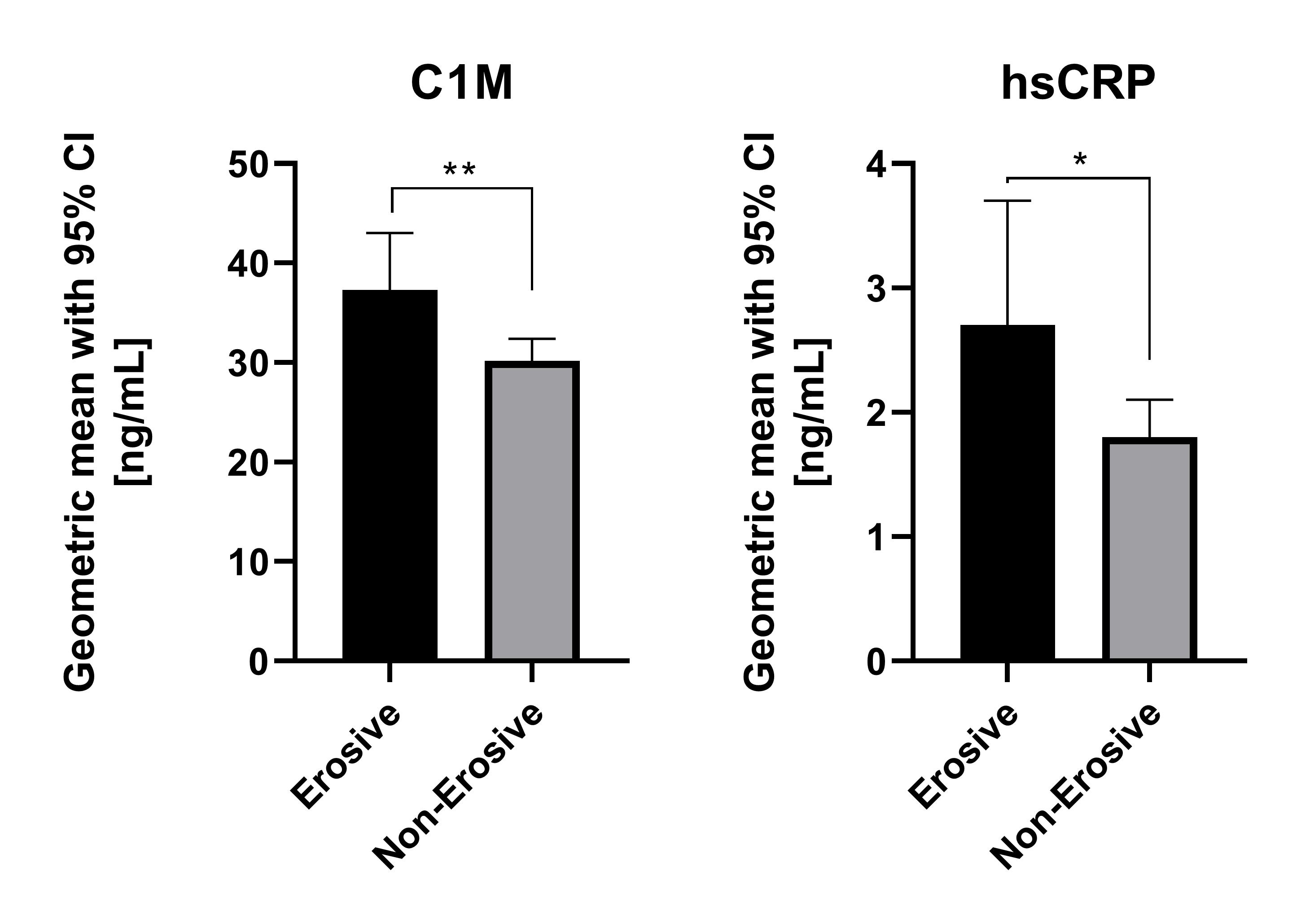Session Information
Session Type: Poster Session C
Session Time: 9:00AM-11:00AM
Background/Purpose: Hand osteoarthritis (OA) is a common degenerative joint disease affecting mainly the interphalangeal and first carpometacarpal joints. The disease manifests as inflammation and deterioration of joint structure leading to pain, loss of function, and reduced quality of life. Hand OA presents as different subtypes, where the erosive type is considered a more severe phenotype with more pronounced symptoms, more inflammation and a faster disease progression. The erosive suptype is associatedwith the development of joint erosions followed by characteristic repair and remodeling of the joint plate. Type I collagen turnover, measured by MMP generated type I collagen neo-epitope C1M in serum have previously been associated with synovial inflammation, disease activity and structural progression in rheumatoid arthritis (RA). The aim of this study was to investigate the association between erosive hand OA and systemic levels of C1M.
Methods: Serum was collected from 291 hand OA patients in the Nor-Hand study, a hospital based cohort study exploring the validity of imaging modalities and disease processes in hand OA. C1M, a measure of MMP mediated type I collagen tissue degradation and the acute phase reactant hsCRP reflecting inflammation was measured at baseline. Bilateral hand radiographs were evaluated by an experienced reader (IKH)(n=287). Erosive hand OA was defined as at least one distal or proximal interphalangeal joint with erosions (defined as E or R stage according to the Verbruggen Veys anatomical phase scoring system). Logistic regression was used to model the odds of having erosive hand OA as function of C1M. C1M was log transformed before entering the model(s). Similar analysis was performed for hsCRP as comparison. All analyses were corrected for age, sex, BMI, and grey scale synovitis of the knee (0-3 scale) or hip (capsule thickness in millimeters) measured by ultrasound.
Results: The greater part of patients were women (n=256, 89%) with a mean (SD) age of 60.8 (6.2) years. 58 (20 % ) patients were identified with erosive hand OA. These patients had higher levels of both C1M and hsCRP than patients with non-erosive disease (Table). A 10% increase in C1M was associated with an increase in the odds of having erosion by 1.069 (95% CI 1.016 – 1.126). The estimated odds ratio was similar after adjustment for clinical and demographic covariates (OR = 1.072; 95% CI 1,014 – 1.134). In comparison, a 10% increase in hsCRP was associated with an increase in odds by 1.027 (95% CI 1.016-1.051). The association remained after adjustment for covariates (OR=1.031; 95%CI 1.004-1.059).
Conclusion: MMP driven turnover of type I collagen measured by C1M, is associated with the presence of erosive hand OA, which is considered a more inflammatory phenotype. These findings suggest that systemic C1M levels may reflect specific pathological joint tissue alterations, and may be a potential biomarker in hand OA studies. Future studies are needed to explore the associations with synovitis and the sensitivity to change.
To cite this abstract in AMA style:
Thudium C, Sharma N, Gløersen M, Frederiksen P, Bay-Jensen A, Haugen I. MMP Mediated Type I Collagen Degradation Is Associated with Erosive Hand Osteoarthritis in a Hospital-based Observational Cohort – the NOR-HAND Study [abstract]. Arthritis Rheumatol. 2020; 72 (suppl 10). https://acrabstracts.org/abstract/mmp-mediated-type-i-collagen-degradation-is-associated-with-erosive-hand-osteoarthritis-in-a-hospital-based-observational-cohort-the-nor-hand-study/. Accessed .« Back to ACR Convergence 2020
ACR Meeting Abstracts - https://acrabstracts.org/abstract/mmp-mediated-type-i-collagen-degradation-is-associated-with-erosive-hand-osteoarthritis-in-a-hospital-based-observational-cohort-the-nor-hand-study/

